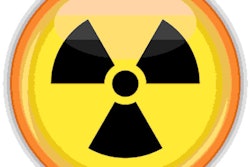
Establishing diagnostic reference levels (DRLs) for radiation dose is a powerful tool for reducing radiation exposure in CT, according to a study by Canadian researchers published in the May issue of the American Journal of Roentgenology.
Researchers from Halifax, Nova Scotia, performed a comprehensive evaluation of head, chest, abdomen, and pelvis CT scans in their institution, examining differences in dose, scanner age, detector rows, and image quality. They created dose reference levels for the province for each exam type, based on the 75% percentile of patient dose distributions, and implemented the DRLs throughout Nova Scotia.
A sample of images evaluated before and after the protocol changes showed no degradation of image quality; however, overall radiation dose fell by nearly half.
"Implementation of DRLs allowed a dose reduction of up to 41%, as was confirmed by the survey conducted after the change in protocol," wrote Dr. Elena Tonkopi and colleagues from the Nova Scotia Health Authority and Dalhousie University. "Periodic review of scan protocols and techniques is important in CT dose management, and each institution should compare its dose values with the respective DRLs."
New strategies
Concerns about increasing radiation exposure with the growth of CT over the past two decades have driven the adoption of new dose-reduction strategies. The implementation of diagnostic reference levels is a powerful tool for identifying CT exams with dose levels that are unusually high compared to reference standards in an institution, the authors wrote (AJR, May 2017, Vol. 208:5, pp. 1073-1081).
Introduced in 1991 by the International Commission on Radiological Protection (ICRP), DRLs are useful for monitoring dose and intervening when levels exceed agreed-upon standards. DRLs are typically set at the 75th percentile of an institution's dose, to be exceeded only as necessary for good practice, they wrote. DRLs are typically based on CT dose index volume (CTDIvol) and dose-length product (DLP), the measures employed in this study.
The first Canadian radiation dose survey of the most common CT exams was performed in 2013, but the data were incomplete, according to Tonkopi and colleagues. Survey participation ended up being less than 50% in Nova Scotia, which also did not analyze the information before forwarding it to Health Canada. The current study was designed to evaluate radiation doses from the most common CT exams of adults, evaluate the effect of scanner capabilities, establish provincial DRLs, and examine the effects of DRLs on patient dose reduction.
"The goals of our study were not only to collect the data and establish provincial reference levels in CT, but also to demonstrate an immediate effect on patient care after implementation of the local DRLs," Tonkopi told AuntMinnie.com by email. "We were concerned with our results that showed huge variations in CT doses, even between identical scanners."
The exams studied included head CT, low-dose chest, abdomen and pelvis, and chest, abdomen, and pelvis. Imaging was performed on nine different scanner models from four manufacturers installed at 12 hospital sites in Nova Scotia. All CT scanners were equipped with 16 to 128 detector rows, with most scanners having 64. Automated x-ray tube current modulation was implemented on all scans.
The researchers defined provincial DRLs as the 75% percentile of dose distribution for each protocol. They calculated mean CTDIvol and DLP values for every scanner and compared them with the provincial DRLs. The investigators reviewed 225 exams in all.
Experienced radiologists blinded to clinical results reviewed a randomized sample of abdomen and chest exams and rated image quality. The analysis included determining whether the image was diagnostic. A second blinded analysis of abdomen and pelvis exams as well as low-dose chest CT was more detailed.
After the initial scans, the researchers offered feedback to the sites and dose reduction recommendations, followed by another survey. The initial survey included data from 1,185 patients, and an additional 180 patients were surveyed after protocols had been optimized.
Sizeable dose reductions
The results showed statistically significant differences between the mean values of dose distributions from each scanner (p < 0.05). The greatest variations were seen in low-dose chest CT, which showed more than a fivefold difference in mean dose values between scanners, according to the authors.
As for image quality, there were no statistically significant differences in any scoring categories, except for the noise category in abdominal imaging.
| Dose changes after protocol modification | |||
| Study type | Dose reduction after modification | Change in mean DLP value, before to after modification (mGy·cm) | Provincial DRL for CTDIvol (mGy) |
| Abdomen and pelvis CT | 33.6%-40.4% | From 571.8 to 531.8 | 13 |
| Chest, abdomen, and pelvis CT | 30.9%-40% | From 902 to 837.2 | 12 |
| Head CT | 2.2%-22% | From 945.5 to 912.4 | 62 |
The Pearson correlation coefficient showed only a very weak positive correlation between the dose and the scanner age (0.043 < r < 0.260), and only a weak negative correlation between the dose and the number of detector rows (-0.173 < r < -0.028), Tonkopi and colleagues wrote.
"The main reason for the wide variations in dose between the scanners is the variability in scanning protocols, which depends not so much on the scanner capability as on hospital preferences," they wrote.
For example, the highest head CT dose was for two different scanners at different sites. Meanwhile, low-dose chest scans showed even higher variability of up to 5.4-fold.
Previous studies have shown that low-dose chest CT can substantially reduce patient dose; however, there are no established guidelines for diagnostic low-dose chest protocols versus the low-dose chest protocols used in the context of CT for lung cancer screening, they wrote. Standardization is required for this exam.
Creating provincial DRLs permits an effective reduction in patient dose without resulting in degradation of image quality, the group concluded.
"Radiologists, referring physicians, and patients need to be aware that the 'low-dose' label may be nothing more than a label and is actually in no way a guarantee that the lowest dose possible was used," Tonkopi told AuntMinnie.com. "When we released the initial dose survey results, some of the institutions called us -- they had no idea their doses were so high. Even the newest scanners may result in unnecessarily high doses if the protocols are not optimized."
Limitations of the study included a small sample size, the authors wrote. Body mass index would have been a better descriptor of a standard-sized patient, but weight was used instead because it was easier to collect.
"In our institution, we have five CT scanners, and annual dose surveys are part of the quality control program," Tonkopi said. "Typically, we include 15 of the most requested examinations. Protocol changes are also followed up with dose data collection. Unfortunately, we have limited resources to implement this practice throughout the province; however, we are hoping to do a follow-up provincial study to introduce additional CT protocols."




















